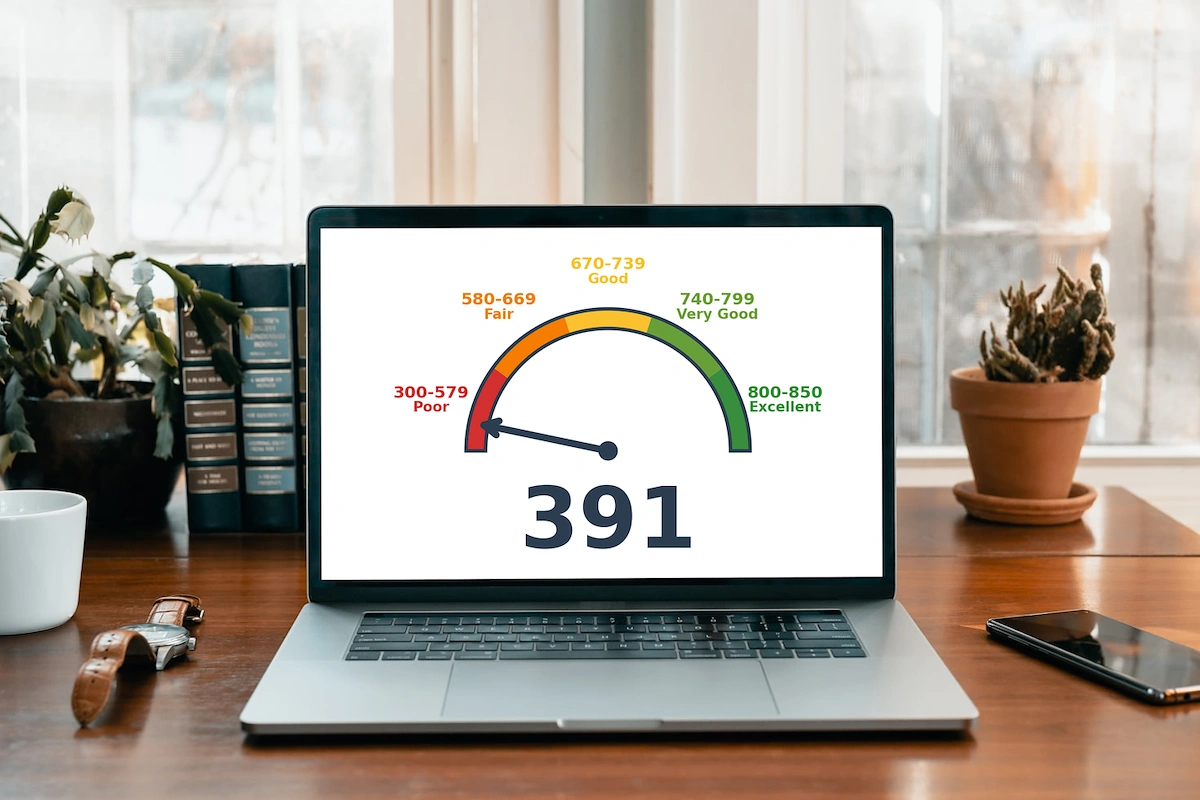
Kudos has partnered with CardRatings and Red Ventures for our coverage of credit card products. Kudos, CardRatings, and Red Ventures may receive a commission from card issuers. Kudos may receive commission from card issuers. Some of the card offers that appear on Kudos are from advertisers and may impact how and where card products appear on the site. Kudos tries to include as many card companies and offers as we are aware of, including offers from issuers that don't pay us, but we may not cover all card companies or all available card offers. You don't have to use our links, but we're grateful when you do!
391 Credit score: What You Need to Know in 2025
July 1, 2025


TL;DR
A 391 credit score presents a significant opportunity for improvement, as it falls into the “Poor” FICO score category. This simply provides a clear roadmap for building a stronger financial profile and unlocking more favorable lending terms in the future.
What Does a 391 Credit Score Mean?
A credit score of 391 places you in the "poor" category of the FICO Score range (300-850), signaling to lenders that you are a very high-risk borrower. This creates significant financial roadblocks, making it difficult to get approved for loans or credit cards. Any credit you do secure will likely come with steep interest rates and unfavorable terms, making borrowing expensive.
While a 391 score presents considerable hurdles, it isn't a permanent label. It's a reflection of past credit history, not a prediction of your financial future. Understanding what led to this score is the first step on the path to rebuilding. Over time, it is possible to improve your credit standing and unlock more favorable financial opportunities.
Who Has a 391 Credit Score?
While age isn't a direct factor in credit scoring, there is a clear trend of scores increasing over time. Here's a look at the average credit scores by generation for 2023:
- Generation Z (Ages 18-26): 680
- Millennials (Ages 27-42): 690
- Generation X (Ages 43-58): 709
- Baby Boomers (Ages 59-77): 745
- Silent Generation (Ages 78+): 760
Credit Cards With a 391 Credit Score
A credit score of 391 places you in the "very poor" credit range, which will make qualifying for most credit cards a significant challenge. Lenders generally see this level of credit as high-risk, leading to likely denials for standard unsecured cards that offer rewards or low interest rates. Consequently, your most viable options will probably be secured credit cards or other cards specifically designed for individuals looking to rebuild their credit history.
Kudos offers AI-powered tools that can help you navigate the credit card market by providing personalized recommendations based on your financial goals. Whether you're looking to build credit or find a card that aligns with your current financial standing, these tools help you compare options and understand how different cards might impact your credit score.
Auto Loans and a 391 Credit Score
A 391 credit score places you in the deep subprime category, making it challenging but not impossible to secure an auto loan. Lenders view this score as high-risk, so you should expect to face some of the highest interest rates offered.
- Super-prime (781-850): 5.25% for new cars and 7.13% for used cars
- Prime (661-780): 6.87% for new cars and 9.36% for used cars
- Non-prime (601-660): 9.83% for new cars and 13.92% for used cars
- Subprime (501-600): 13.18% for new cars and 18.86% for used cars
- Deep subprime (300-500): 15.77% for new cars and 21.55% for used cars, based on Experian Q2 2025 data.
Mortgages at a 391 Credit Score
With a 391 credit score, qualifying for a traditional mortgage is highly unlikely. According to current requirements, even the most accessible FHA loans require a minimum score of 500. Conventional loans demand at least a 620. A score this low falls far below the minimum threshold for mainstream lenders, making a loan denial almost certain.
In the rare event you found a specialty lender, a 391 score would lead to severe disadvantages. Expect to face extremely high interest rates, a substantial down payment requirement, and costly fees. Lenders view such a low score as a significant risk, and the loan's terms would reflect that, making homeownership far more expensive.
What's in a Credit Score?
Figuring out what goes into your credit score can feel like trying to solve a complex puzzle, but it generally boils down to a handful of key elements. The most common factors include:
- Your history of making payments on time is the most significant factor.
- How much of your available credit you're currently using, known as your credit utilization ratio, plays a major role.
- The age of your credit accounts, including the average age and the age of your oldest account, is also considered.
- Lenders like to see that you can responsibly manage different types of credit, such as credit cards and loans.
- Opening several new credit accounts in a short period can be seen as a risk and may temporarily lower your score.
How to Improve Your 391 Credit Score
Your credit score plays a vital role in your financial life, but a low number isn't a life sentence; there are proven methods to improve your creditworthiness. With consistent effort, you can see meaningful changes and build a healthier credit profile.
- Apply for a secured credit card. Since these cards require a security deposit, they are easier to obtain with damaged credit and allow you to build a positive payment history. Your on-time payments are reported to the credit bureaus, which is the most significant factor in your score.
- Become an authorized user. Being added to a responsible person's credit card account can add their positive payment history and low credit utilization to your report. This can be a fast way to boost your score, provided the primary account holder maintains good habits.
- Consider a credit-builder loan. These loans are specifically designed to help establish a positive payment history as your payments are reported to credit bureaus. This also helps diversify your credit mix, showing lenders you can handle different types of credit products.
- Address collection accounts. Accounts in collections have a severe negative impact on your score, and addressing them is a critical step. Negotiating a settlement or a "pay-for-delete" agreement can remove the negative item from your report and stop it from continuing to drag your score down.
To help manage your cards and track your progress as you rebuild, a financial companion like Kudos can be a valuable tool.

Supercharge Your Credit Cards
Experience smarter spending with Kudos and unlock more from your credit cards. Earn $20.00 when you sign up for Kudos with "GET20" and make an eligible Kudos Boost purchase.
Editorial Disclosure: Opinions expressed here are those of Kudos alone, not those of any bank, credit card issuer, hotel, airline, or other entity. This content has not been reviewed, approved or otherwise endorsed by any of the entities included within the post.




























.webp)
.webp)
.webp)
%20(1).webp)
.webp)


.webp)
.webp)
%20(1).webp)